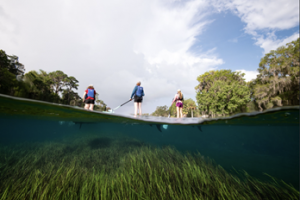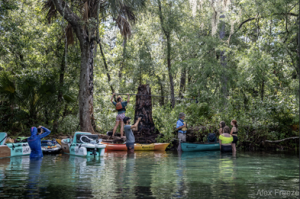We’re highlighting all things Florida Master Naturalist Program (FMNP) in 2021 as the program marks its 20th anniversary. To learn more about FMNP, view the first blog post here.

By Haley Hanson and Nicole Brand
This month we are excited to feature the Florida Wildlife Corridor Coalition’s latest expedition, Spring2Shore, and the FMNP instructors who assisted along the way.
The connectivity of landscapes is more important now than ever. With increased habitat loss and fragmentation, wildlife need places to move and roam. Plants require areas that are not disturbed.

How do we combat the ever-present threat of encroachment on natural spaces? The Florida Wildlife Corridor Coalition has some answers. For decades, this organization has advocated for a connected corridor to be preserved across Florida from the Everglades to Okefenokee.
In order to protect a connected wildlife corridor, the Corridor Coalition needs to get to know the areas’ wildlife, landscape, and potential obstacles to protection. Expeditions are one way to work toward this goal.
The group’s first expedition was inspired by the movements of a GPS-collared black bear named M34. Researchers observed M34’s movement across the Florida landscape over the year and noted where he spent his time, his perilous road crossings (including I-4), and the distance he traversed. Overall, M34 moved about 500 miles in about eight weeks. Utilizing some of the same spaces as M34, the Florida Wildlife Corridor Coalition trekked from the Everglades to Okefenokee, in order to bring awareness to the vulnerable green spaces that are necessary for animals to travel across the state.
Over the years, the group has completed a number of expeditions, all highlighting spaces that need protection and bringing much needed attention to protect ecological connectivity throughout the state.
This year, they embarked on a new kind of Expedition to see the Corridor through the eyes of a younger generation. Trekkers Ava Moody (16 years old, rising junior), Marin Best (14 years old, rising freshman), and Mallori Best (16 years old, rising junior) will share the message of corridor conservation to new audiences. The FMNP was invited to help with the Expedition, named Spring2Shore.

Before the expedition began, Florida Master Naturalist instructors Jeanne Murphy and Brian Lane with Sensing Nature, Kelly Ussia with St. Johns County Parks and Recreation, and Jennifer Hunt, Rachael Cravens, and Jackie Rolly with Oakland Nature Preserve gave their input and offered suggestions on how to best formulate a youth expedition through the wild Florida landscape that fostered educational connections for the youth trekkers. These conversations were critical to the planning process.
The Expedition covered 50 miles across 4 days, beginning at Rainbow Springs headwaters and ending at the Gulf of Mexico. This region is particularly important for conservation efforts, as there is a narrow corridor just north of Dunnellon, which is partly within the city limits. The narrower a corridor is, the more at risk it is to be severed.
Lars Andersen, lead FMNP instructor in Alachua County, came out to guide, instruct and paddle with the trekkers throughout their journey. An FMNP instructor for over a decade, Lars has been teaching about Florida’s ecosystems for much longer. Through his business, Adventure Outpost, he leads ecotours of over 60 waterways across Florida, making him uniquely suited to explore with Spring2Shore.

On the first day, the trekkers paddled past a bottleneck connection point between the Ocala National Forest and Goethe State Forest. This region, where the Rainbow River and Withlacoochee River flow, are beautiful and diverse wild places with vital connections to the Gulf. Not only is Rainbow River exceptionally important for conservation efforts, Lars shared, but it highlights many changes that springs and waterways across Florida are experiencing.
Many springs in Florida, including Rainbow Springs, have lost a significant amount of flow due to the reduction of water in the aquifer due to human consumption and agriculture. Reaching the gulf, the group saw the consequences of human impacts on the springs: miles and miles of dead trees due to less fresh water entering the estuary.

It is not all bad news, though. Lars was inspired by the trekkers and expects that their efforts and activism can help protect the springs.
“Spending four days on the river with this crew and teaching these three amazing girls about the nature of Rainbow and Withlacoochee rivers was a high point in my guiding/writing career,” Lars said. “One of the highlights of the trek was when the microphones were momentarily turned off for adjustments and the girls kept asking questions about the geology and wildlife of the river. At that moment, I realized they were all-in with the efforts to preserve wild Florida.”

Nature Coast towns like Dunnellon, Yankeetown, Crystal River and Homosassa, depend on the geographic Florida Wildlife Corridor. Those communities’ economies depend on visitors snorkeling, swimming and paddling the springs and rivers, going on manatee tours, hiking and biking the trails, eating in local restaurants and staying in local hotels. Land protection within the corridor helps sustain the wildlife and habitat that supports these economies.
The Florida Wildlife Corridor already exists; it isn’t something that needs to be “created.” Just last month, the Florida Wildlife Corridor Act was passed, allocating money and resources that will support making the Coalition’s mission a reality.
The Florida Wildlife Corridor Coalition will be joining us Nov. 3 at 3:30 pm on Zoom during the FMNP Festival to give an overview on the conservation science of the Corridor and an opportunity for participants to explore some of the Spring2Shore path with the Corridor Coalition and FMNP instructors.
Interested in taking a tour with Lars? Find more information about Adventure Outpost here.
 0
0
